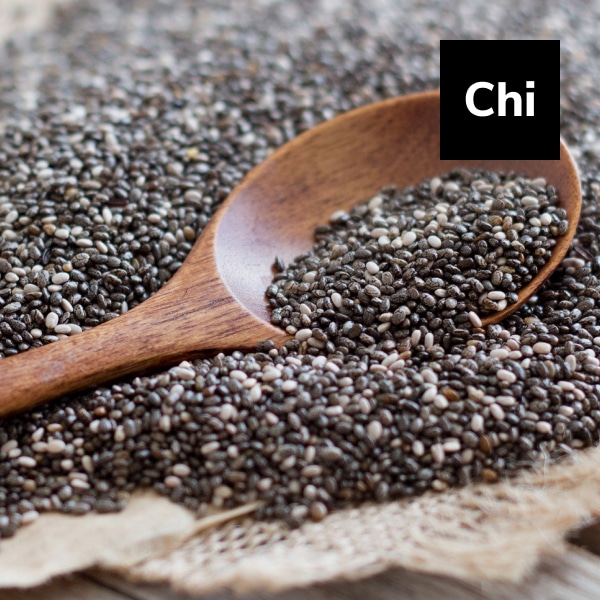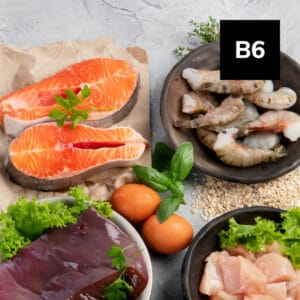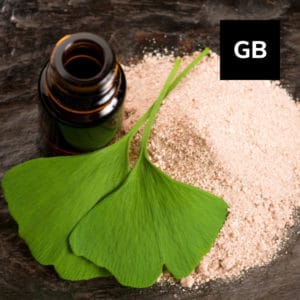Overview
Chia is the ancient Mayan word for strength. Although it has a very long history as a staple in indigenous cultures, it has recently become popular as a superfood throughout the world. It contains a wide range of nutrients and is considered one of the most nutritious foods on the planet.
Key Benefits
- Offers antioxidant protection
- Provides healthy fat (Omega-3s) and numerous nutrients*
- Helps support healthy weight (2 Tbsp of chia seeds have almost 10 grams of fiber and diets high in fiber have been linked to weight loss.)
- Supports cardiovascular health
- Helps control post-meal rise in blood sugar
- May help reduce inflammation
History of Usage
Chia seeds (Salvia Hispanica L.) were an important food of the Aztecs and Mayans. In the southwest United States, the seeds of Salvia columbariae, a closely related plant, were used by Native Americans as a source of protein.
Human studies focused on consuming chia seeds are limited. But the studies that exist point to very promising benefits of incorporating chia seeds into one’s diet. They can be soaked, which makes them absorb water and develop a gelatinous texture. Or they can be directly included in cooked cereal, cold cereal, smoothies, puddings, breads, etc. Chia seeds can also be sprouted and added to salads, sandwiches, and other dishes.
Biochemistry
Chia seeds are a low-carb, whole food that contains fiber, protein, omega-3 fatty acids, amino acids, calcium, manganese, magnesium, phosphorus, zinc, and vitamins B1, 2, and 3. They contain more omega-3s than salmon, gram for gram, although plant omega-3s are inferior to animal sources like fish oil because the omega-3s in chia are mostly alpha-linolenic acid (ALA). ALA needs to be converted into EPA and DHA before the body can use it and the human body is not efficient at converting ALA to EPA and DHA.
Recent Trends
There will be a $22.3 percent compound annual growth rate (CAGR) for the world’s total chia seed industry by 2025.
The United States and Australia have the highest demand for chia seeds and chia-based products. However, the markets in the United Kingdom, Brazil, Chile, and Spain have shown a substantial increase in their demand for the seeds. Demand for chia seeds is being driven by a rise in the popularity of gluten-free and ancient grain goods made from multiple kinds of cereal. As a rule, (Chia seeds are gluten-free).
Chia seeds are most popular in North America. The American Heart Association recommends including omega-3 rich foods and oils in the daily diet to prevent heart disease, and chia seeds are high in omega 3s. Also, chia seeds are neutral in taste and easy to incorporate in a variety of foods and products. Chia seeds are labeled as “superfoods,” which is very attractive to consumers.
Chia seeds are being increasingly integrated into snacks, energy drinks, and cereals.
Precautions
Chia seeds are safe for most people. People who are allergic to mint, sesame, or mustard seeds should avoid chia seeds.
References
- Sandoval-Oliveros MR, Paredes-López O. Isolation and characterization of proteins from chia seeds (Salvia hispanica L.). J Agric Food Chem. 2013 Jan 9;61(1):193-201. doi: 10.1021/jf3034978. Epub 2012 Dec 28. PMID: 23240604.
- Olivos-Lugo BL, Valdivia-López MÁ, Tecante A. Thermal and physicochemical properties and nutritional value of the protein fraction of Mexican chia seed (Salvia hispanica L.). Food Sci Technol Int. 2010 Feb;16(1):89-96. doi: 10.1177/1082013209353087. Epub 2010 Feb 5. PMID: 21339125.
- Ayaz A, Akyol A, Inan-Eroglu E, Kabasakal Cetin A, Samur G, Akbiyik F. Chia seed (Salvia Hispanica L.) added yogurt reduces short-term food intake and increases satiety: randomised controlled trial. Nutr Res Pract. 2017 Oct;11(5):412-418. doi: 10.4162/nrp.2017.11.5.412. Epub 2017 Sep 21. PMID: 28989578; PMCID: PMC5621364.
- Vuksan V, Jenkins AL, Brissette C, Choleva L, Jovanovski E, Gibbs AL, Bazinet RP, Au-Yeung F, Zurbau A, Ho HV, Duvnjak L, Sievenpiper JL, Josse RG, Hanna A. Salba-chia (Salvia hispanica L.) in the treatment of overweight and obese patients with type 2 diabetes: A double-blind randomized controlled trial. Nutr Metab Cardiovasc Dis. 2017 Feb;27(2):138-146. doi: 10.1016/j.numecd.2016.11.124. Epub 2016 Dec 9. PMID: 28089080.
- Vuksan V, Whitham D, Sievenpiper JL, Jenkins AL, Rogovik AL, Bazinet RP, Vidgen E, Hanna A. Supplementation of conventional therapy with the novel grain Salba (Salvia hispanica L.) improves major and emerging cardiovascular risk factors in type 2 diabetes: results of a randomized controlled trial. Diabetes Care. 2007 Nov;30(11):2804-10. doi: 10.2337/dc07-1144. Epub 2007 Aug 8. PMID: 17686832.
- Toscano LT, da Silva CS, Toscano LT, de Almeida AE, Santos Ada C, Silva AS. Chia flour supplementation reduces blood pressure in hypertensive subjects. Plant Foods Hum Nutr. 2014 Dec;69(4):392-8. doi: 10.1007/s11130-014-0452-7. PMID: 25403867.
- Vuksan V, Jenkins AL, Dias AG, Lee AS, Jovanovski E, Rogovik AL, Hanna A. Reduction in postprandial glucose excursion and prolongation of satiety: possible explanation of the long-term effects of whole grain Salba (Salvia Hispanica L.). Eur J Clin Nutr. 2010 Apr;64(4):436-8. doi: 10.1038/ejcn.2009.159. Epub 2010 Jan 20. PMID: 20087375.
- Ho H, Lee AS, Jovanovski E, Jenkins AL, Desouza R, Vuksan V. Effect of whole and ground Salba seeds (Salvia Hispanica L.) on postprandial glycemia in healthy volunteers: a randomized controlled, dose-response trial. Eur J Clin Nutr. 2013 Jul;67(7):786-8. doi: 10.1038/ejcn.2013.103. Epub 2013 Jun 19. PMID: 23778782.




